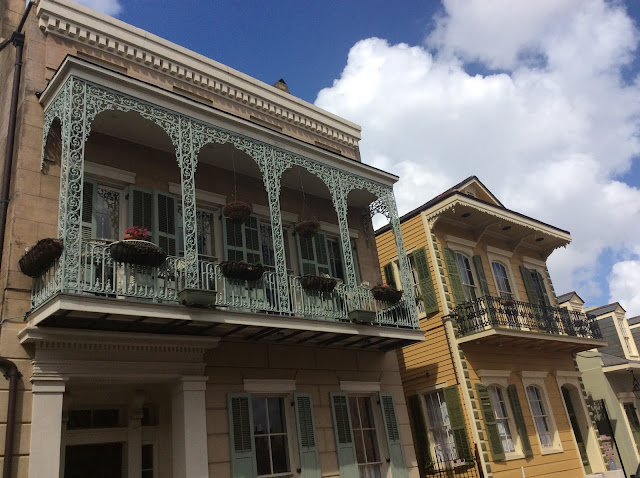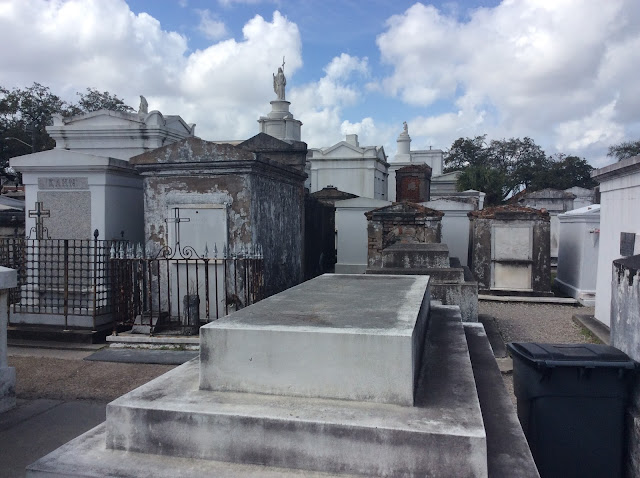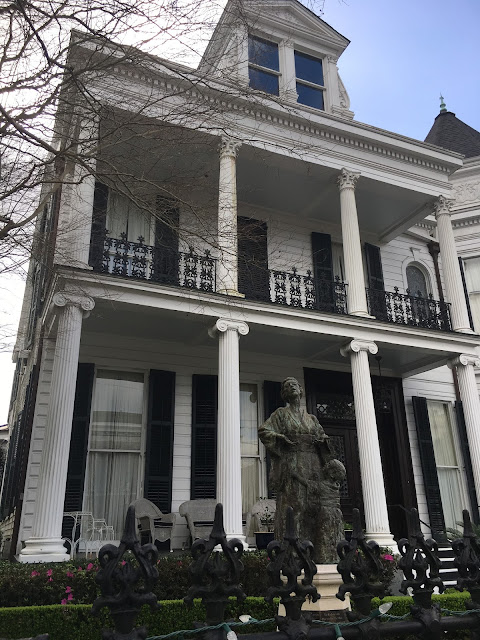People smile when they talk about New Orleans, and I can see why. It's a city with the reputation for partying (read Bourbon Street!), cuisine (read Cajun and creole), great music (read jazz and zydeco) and creative license, but there is so much more. Having lead a Hoffy Tour to two of the most beautiful cities in the South - Savannah and Charleston, I was eager to find out how the Big Easy compared. What I found was a fascinating city with rich history, distinctive architecture, and gracious people.
 |
| Like the Spanish colonists in the New Word, the French laid out the city starting with a plaza - in this case Jackson Square. Both Jackson Square (also known as La Place de Arms) and the French Quarter are National Historic Landmarks - the highest historic designation in the US. |
 |
When Spain took over Louisiana, they renamed the original French plaza. The Laws of the Indies
required the Spanish to include a plaza in every settlement in the New World. |
If you have only three or four days in New Orleans, here's my Hoffy Tours top five list of things to do: 1) Explore the French Quarter and take a walking tour (and a ghost tour at night); 2) Take the St. Charles Streetcar and go explore the Garden District (I recommend a walking tour here too); 3) Visit the World War II Museum. It could be the best in the US. 4) Rent a car and go explore the plantations along the Mississippi River. Most of the plantations are only 45 minutes by car - I recommend the Laura Plantation and Oak Alley; and 5) Take a swamp tour. I like the company Cajun Pride: wonderful guides and lots of gators!
The French Quarter or Vieux Carre, the original settlement on the Mississippi founded in 1718, is the historical, cultural, party and tourist hub of New Orleans. Its grid pattern is easy to negotiate and it's got to be the most fun National Historic Landmark District in the nation.
 |
| Music is everywhere in the French Quarter. This jazz band is playing in front of St. Louis Cathedral. |
 |
| The most distinctive feature of the French Quarter architecture is the wrought and cast iron decorative balconies - a legacy of the Spanish period. The architecture of the French Quarter is actually a delightful blend of French, Spanish, Creole and American styles. |
 |
| The distinctive street signs and lamps are unifying elements of the French Quarter. |
 |
The street life of the French Quarter is vibrant. Since the Quarter is over two hundred years old, there
are no parking lots to break up the continuous blocks of buildings. The result is wonderful urban space. |
A major attraction in New Orleans is the Garden District, a large, mostly residential, area of stately Greek Revival mansions and smaller cottages southwest of the French Quarter. For reasons I had trouble understanding, the area is called "Uptown New Orleans" as well. Regardless, the tree-lined district has some of the best preserved and outstanding 19th century mansions in the South. And half the fun is getting there on the St. Charles streetcar pictured below.
 |
The quaint St. Charles Streetcar leaves downtown and cuts right through the beautiful Garden District.
We absolutely loved watching the beautiful mansions and huge oak trees roll by! We got off at Audobohn
Park and explored stately Tulane and Loyola Universities. |
 |
| This Italianate home with its cast iron fence is typical of the late 1800s homes in the Garden District. |
 |
Cemetery tours are quite famous in New Orleans. With the tradition of being buried above ground in
Greek Revival tombs adds another element of mystique and wonder to this dynamic city. |
 |
Greek Revival is the most common style in the Garden District. Many of the homes are white, with
ample balconies to provide relief and ventilation. |
 |
Many of the mansions no longer have big yards since large lots were subdivided. The copious balconies and white Classical Revival styles reminded me of Charleston and Beaufort, South Carolina.
|
 |
Commander's Palace Restaurant is a charming place to eat in the Garden District. The well-dressed and attentive staff
showed us service and hospitality that the South is famous for. |
 |
| We loved the stunning Gothic architecture of Loyola University in the Garden District. |
 |
Cast and wrought iron fences and balconies are common throughout the Garden District.
Pictured above is the famous Corn Stalk Fence. The mansion's asking price in 2018 was $5.85 million!
In addition to exploring historic districts, the two other highlights were the World War II Museum and the plantation tours. As a port city, New Orleans played an important role in that conflict and the museum reflects this contribution. It's a huge museum with several large pavilions, and we only had time to see a small part. Nevertheless, I have a recommendation. Pick the part of World War II that you want to learn more about - the European or Pacific Theatre - and head there. The displays are multi-media, comprehensive, chronological and extremely informative. I recommend at least three hours for your visit. I left with an appreciation for our brave armed forces and a greater knowledge of their determined enemies. |
 |
The tour of Laura Plantation was phenomenal. It described the succession of families and strong businesswomen who
ran the plantations and how they had to change to match the economy's needs. Our Creole guide was proud, informative and very passionate, and she helped us step back in time to understand life on the plantation. |
 |
Creole plantation owners often painted their buildings red, yellow and green rather than the ubiquitous white
of many of the Greek Revival plantations. |
 |
| Here's the "alley of oaks" of the Oak Alley Plantation - one of the most beautiful sights I've ever seen. |
 |
These exhibits at Oak Alley explained the difficult life of the slaves and how they made the plantation profitable. I
was interested to note that Oak Alley is a National Historic Landmark, one of only 2,500 buildings in the entire
country to earn this distinction.
People told us to do a swamp tour while visiting New Orleans. Being a lover of animals and different ecosystems, I happily agreed. Maria and I chose Cajun Pride Swamp Tours, only a half hour from our hotel. The tour was super fun and informative because our Cajun guide not only taught us about the swamps and wildlife, but also explained Cajun culture and cuisine. Alligators, turtles and egrets were abundant, and we were quick to realize that swamps are not smelly and are, in fact, quite beautiful. This protected area is another example of our country preserving its most beautiful wild places. |
 |
Our wonderful Cajun guide made us realize that swamps are not smelly or stagnant and alligators are
pretty incredible and beautiful creatures. |
 |
| Maria actually touched a small alligator, by the way! |
 |
We were impressed by the beauty of the swamps. Because swamp water is constantly moving,
they are clean and NOT smelly. |
 |
| I think we definitely chose the right boat! |
I hope you enjoyed the pictures and brief descriptions. New Orleans and its environs are a national treasure and I hope to lead a tour their in the near future. If you like gracious people, lots of history, stunning architecture, distinctive cuisine, all sorts of music, alcohol, and swamps, visit New Orleans.
 |
| Jesus on Shadow on the St. Louis Cathedral. |
